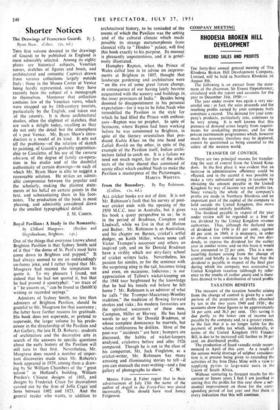Royal Pavilion: A Study in the Romantic.
ONE of the things that everyone knows about Brighton Pavilion is that Sydney Smith said of it that the dome of St. Paul's must have come down to Brighton and pupped." It had always seemed to me an outstandingly un-funny joke, and I rather hoped that Mr. Musgrave had resisted the temptation to quote it. To my pleasure I found, not indeed that he had not quoted it, but that he had proved it apocryphal: "no trace of it" he assures us, "can be found in (Smith's) writing or recorded sayings."
Admirers of Sydney Smith, no less than admirers of Brighton Pavilion, should be grateful to Mr. Musgrave for that assurance ; the latter have further reasons for gratitude. His book does not supersede, or pretend to supersede, the larger volume by his prede- cessor in the directorship of the Pavilion and Art Gallery, the late H. D. Roberts: students of architecture and the decorative arts in search of the answers to specific questions about the early history of the Pavilion will still turn to that first. Nevertheless, Mr. Musgrave does record a number of impor- tant discoveries made since Mr. Roberts's book appeared in 1939, among them a draw- ing by Sir William Chambers of the "great saloon" in Holland's building, William Porden's Chinese designs of 1803, and designs by Frederick Crace for decorations carried out by the firm of Jot% Croe and Sons between 1802 and 1823., And the general reader who wants, in addition to
architectural history, to be reminded of the events of which the Pavilion was the setting and of the cultural climate which made possible its strange metamorphosis from classical villa to " Hindoo " palace, will find this book exactly to his purpose. Its manner is pleasantly unpretentious, and it is gener- ously illustrated.
Humphry Repton, when the Prince of Wales called him in to advise on _improve- ments at Brighton in 1805, thought that landscape gardening and architecture were "on the eve of some great future change, in consequence of our having lately become acquainted with the scenery and buildings in, the inner provinces of India." Besides being doomed to disappointment in his personal expectation—for it was to be John .Nash who remodelled the Pavilion in the style for which he had filled the Prince with enthusi- asm—Repton was no prophet. In spite of Sezincote, where Repton had been working before he was summoned to Brighton, in spite of the literary orientalism that pro- duced Kuhla Khan on the one hand and Lallah Rookh on the other, in spite of the„, example of the Pavilion itself, Indian archi- tecture failed to catch on. It is a failure we need not much regret, for few of the archi- tects of the time shared that command of scenic effect which enabled Nash to make the Pavilion a masterpiece of the Picturesque..
MARCUS WHIFFEN.


































 Previous page
Previous page